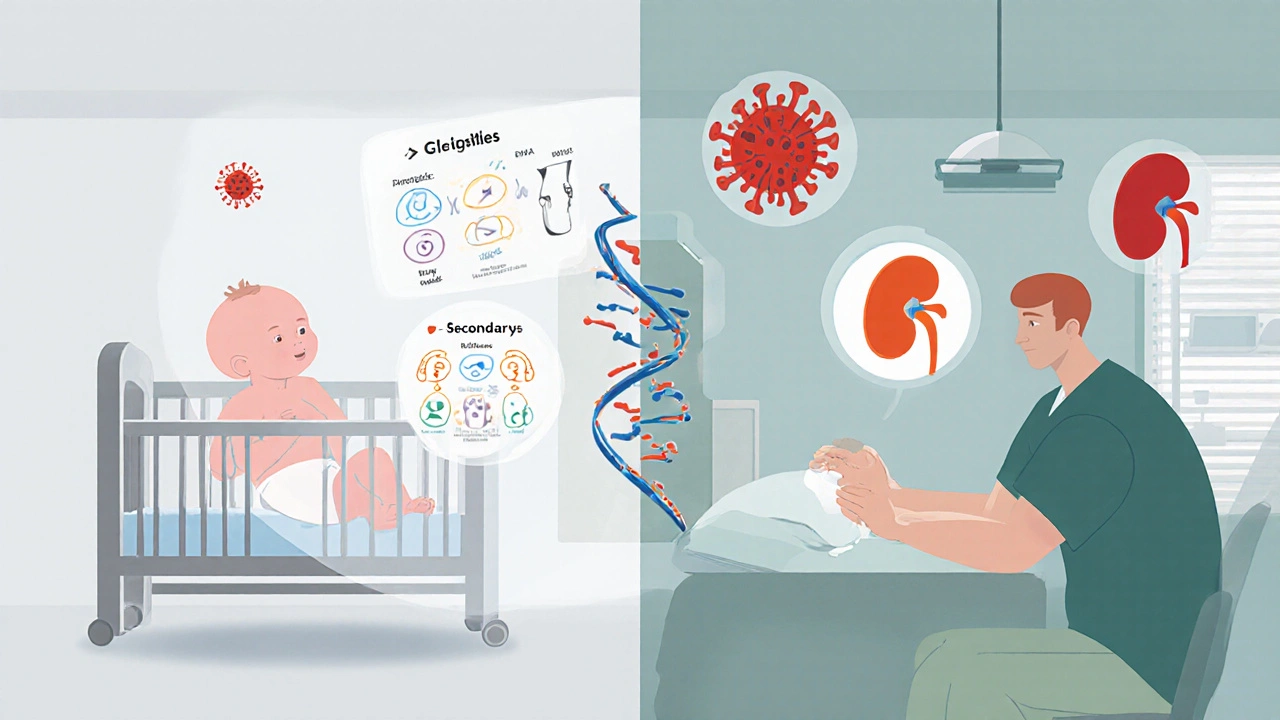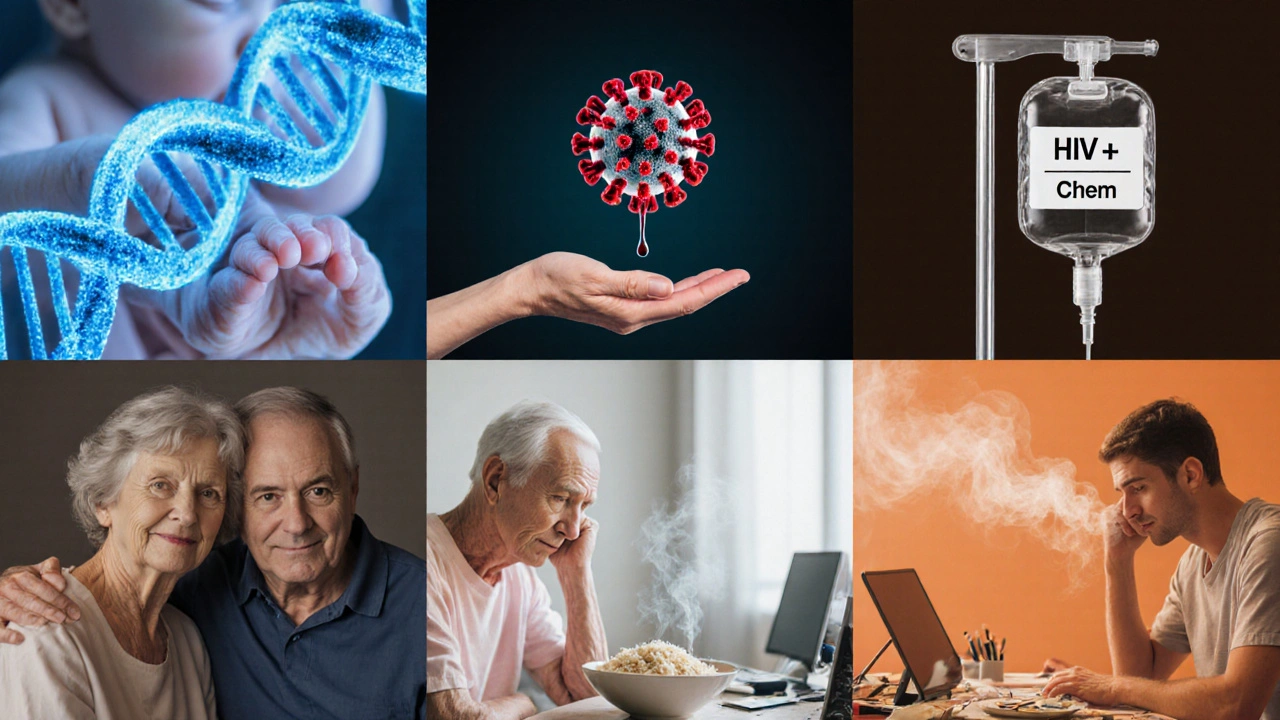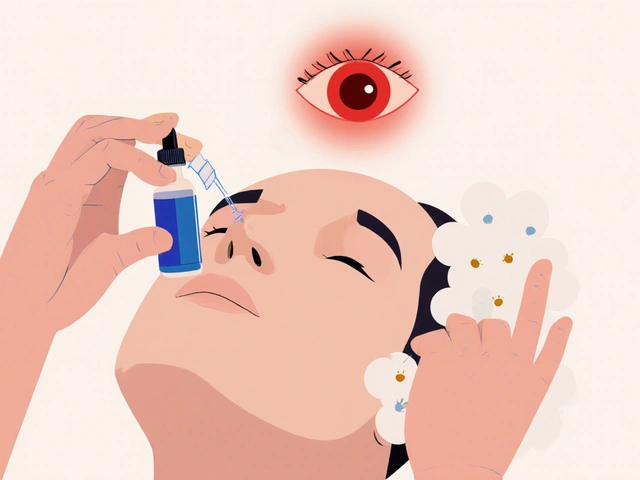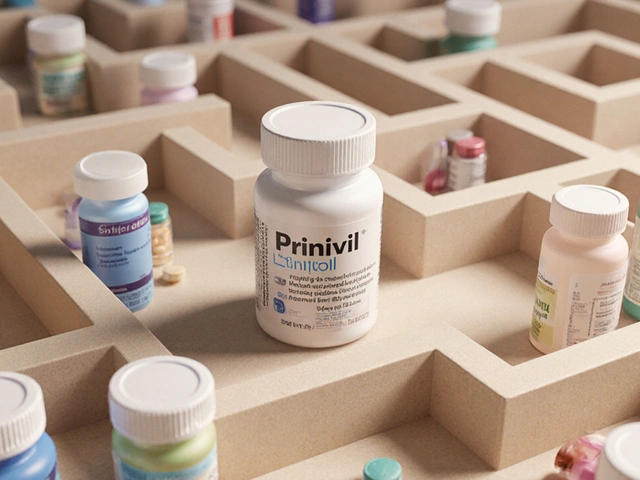Immunodeficiency Disorder Classifier
Classification Result
When your immune system can’t defend you properly, the problem is often an immunodeficiency disorder. These conditions range from rare genetic defects present at birth to acquired weaknesses caused by infections, medications, or lifestyle factors. Below you’ll find a clear rundown of why they happen, how they differ, and what steps you can take if you suspect something’s off.
Quick Takeaways
- Immunodeficiency disorders are split into primary (inherited) and secondary (acquired) groups.
- Genetic mutations, infections like HIV, chemotherapy, steroids, and malnutrition are the top causes.
- Common primary types include Severe Combined Immunodeficiency (SCID) and Common Variable Immunodeficiency (CVID).
- Secondary types often stem from chronic diseases, medical treatments, or environmental stressors.
- Early diagnosis and tailored treatment-immunoglobulin replacement, antibiotics, or lifestyle changes-can dramatically improve outcomes.
What Exactly Is an Immunodeficiency Disorder?
Immunodeficiency disorder is a condition in which the immune system’s ability to fight infections and malignancies is compromised. The defect may affect white blood cells, antibodies, complement proteins, or signaling pathways that coordinate the immune response. When any part of this intricate network falters, the body becomes vulnerable to frequent, severe, or unusual infections.
Root Causes: How Immunodeficiency Happens
Understanding the root cause helps doctors pick the right treatment. Below are the major categories that generate immune weakness.
- Genetic mutations - Inherited changes in DNA that disrupt the development or function of immune cells. These are the hallmark of primary immunodeficiencies.
- Viral infections - HIV, hepatitis C, and certain herpesviruses can directly target immune cells, leading to secondary immunodeficiency.
- Medical treatments - Chemotherapy, radiation, and long‑term corticosteroid use suppress bone‑marrow activity and lymphocyte proliferation.
- Chronic diseases - Diabetes, kidney failure, and autoimmune conditions can wear down immune defenses over time.
- Malnutrition - Deficiencies in protein, zinc, selenium, or vitamins A and D impair antibody production and cell‑mediated immunity.
- Age‑related decline - The immune system naturally weakens in the elderly, a phenomenon known as immunosenescence.

Primary vs. Secondary: The Two Big Buckets
Clinicians first ask whether a disorder is Primary immunodeficiency (inherited) or Secondary immunodeficiency (acquired). The distinction drives testing, counseling, and long‑term management.
| Attribute | Primary Immunodeficiency | Secondary Immunodeficiency |
|---|---|---|
| Typical Onset | Birth to early childhood | Any age, often after a trigger |
| Root Cause | Genetic mutation (single‑gene or chromosomal) | Infection, medication, chronic disease, nutrition |
| Common Examples | SCID, CVID, X‑linked agammaglobulinemia | HIV/AIDS, chemotherapy‑induced, steroid‑induced |
| Treatment Focus | Immune reconstitution (gene therapy, HSCT), immunoglobulin replacement | Address underlying cause, prophylactic antibiotics, vaccination adjustments |
| Prognosis | Variable; early diagnosis improves survival | Often reversible if trigger removed |
Key Types of Primary Immunodeficiency
Primary immunodeficiencies (PIDs) are catalogued in the International Union of Immunological Societies (IUIS) registry, which now lists over 400 distinct disorders. Below are the most frequently encountered.
- Severe Combined Immunodeficiency (SCID) - A life‑threatening lack of functional T‑cells and B‑cells. Babies present with chronic diarrhea, pneumonia, and failure to thrive. Bone‑marrow transplantation or gene‑editing (CRISPR) offers curative potential.
- Common Variable Immunodeficiency (CVID) - Characterized by low immunoglobulin levels and poor vaccine responses. Adults often develop sinus infections, bronchiectasis, and autoimmune complications.
- X‑linked Agammaglobulinemia (XLA) - Mutations in the BTK gene block B‑cell maturation. Young males suffer recurrent bacterial infections; regular immunoglobulin infusions are standard care.
- DiGeorge Syndrome - A microdeletion on chromosome 22q11.2 leading to thymic hypoplasia. Affected individuals have T‑cell deficits, cardiac defects, and facial dysmorphisms.
- Hyper‑IgM Syndrome - Defects in CD40L or activation‑induced cytidine deaminase prevent class‑switch recombination, leaving patients with high IgM but low IgG/IgA.
Common Secondary Immunodeficiency Scenarios
Secondary immunodeficiencies (SIDs) are usually reversible once the underlying factor is managed.
- HIV/AIDS - The virus attacks CD4+ T‑cells, gradually eroding cellular immunity. Antiretroviral therapy (ART) restores CD4 counts and reduces opportunistic infections.
- Chemotherapy - Cytotoxic drugs kill rapidly dividing marrow cells, dropping neutrophil and lymphocyte counts. Growth‑factor support (G‑CSF) and prophylactic antibiotics help bridge the low‑count window.
- Long‑Term Corticosteroids - Steroids suppress cytokine production and impede leukocyte migration. Tapering the dose or switching to steroid‑sparing agents can restore immune function.
- Chronic Kidney Disease (CKD) - Uremia impairs neutrophil chemotaxis and complement activity. Dialysis, renal transplantation, and vaccination adjustments mitigate infection risk.
- Protein‑Calorie Malnutrition - Deficits in essential amino acids and micronutrients blunt antibody synthesis. Nutritional rehabilitation reverses most deficits.
Diagnostic Checklist: What to Expect
If you or a loved one shows signs of frequent infections, doctors usually follow a step‑by‑step workup.
- Detailed medical and family history - looking for early‑onset infections or consanguinity.
- Complete blood count with differential - to spot neutropenia, lymphopenia, or eosinophilia.
- Quantitative immunoglobulins (IgG, IgA, IgM) - low levels point to B‑cell issues.
- Specific antibody response testing - assesses vaccine‑induced immunity.
- Flow cytometry - counts T‑cell subsets (CD4, CD8), B‑cells, NK cells.
- Genetic sequencing - panels or whole‑exome sequencing identify causative mutations.
- Functional assays (e.g., nitroblue tetrazolium test) - evaluate phagocyte oxidative burst.

Management Strategies: From Prevention to Cure
Treatment is highly personalized, but core principles apply across most disorders.
- Immunoglobulin replacement - Intravenous (IVIG) or subcutaneous (SCIG) antibodies boost protection in antibody‑deficient patients.
- Antimicrobial prophylaxis - Trimethoprim‑sulfamethoxazole for Pneumocystis, azithromycin for atypical mycobacteria.
- Vaccination tailoring - Use inactivated vaccines; avoid live vaccines in severe T‑cell deficits.
- Hematopoietic stem cell transplantation (HSCT) - Curative for many SCID forms and selected PIDs.
- Gene therapy - Emerging option for ADA‑deficient SCID and X‑linked chronic granulomatous disease.
- Lifestyle adjustments - Hand hygiene, avoiding crowds during flu season, and nutritional optimization.
When to Seek Medical Help
Don’t wait for the third bout of sinus infection. See a healthcare professional if you notice any of the following:
- More than two serious infections (pneumonia, sepsis, meningitis) within a year.
- Persistent diarrhea or failure to thrive in children.
- Unusual infections such as thrush, oral warts, or opportunistic fungal diseases.
- Recurrent skin abscesses that don’t heal quickly.
- Family history of early‑onset immunodeficiency.
Frequently Asked Questions
What is the difference between primary and secondary immunodeficiency?
Primary immunodeficiency is inherited or caused by a genetic mutation present from birth, while secondary immunodeficiency develops later due to external factors like infections, medications, or chronic illnesses.
Can immunodeficiency disorders be cured?
Some primary disorders (e.g., SCID) can be cured with stem‑cell or gene therapy. Most secondary forms improve once the underlying cause is treated, and chronic primary disorders are managed with lifelong replacement therapy and infection prevention.
How are immunodeficiencies diagnosed?
Diagnosis combines medical history, blood tests (CBC, immunoglobulin levels), flow cytometry for lymphocyte subsets, functional assays, and increasingly, genetic sequencing to pinpoint mutations.
Is it safe to receive vaccines if I have an immunodeficiency?
Inactivated vaccines are generally safe and recommended. Live vaccines may be contraindicated for severe T‑cell deficiencies, so doctors tailor immunization schedules based on the specific disorder.
What lifestyle changes help strengthen a weakened immune system?
Balanced nutrition (adequate protein, zinc, selenium, vitamins A, C, D, E), regular moderate exercise, good sleep hygiene, stress management, and strict hand‑washing reduce infection risk for anyone with an immunodeficiency.
Next Steps and Troubleshooting
If testing confirms an immunodeficiency, work with an immunologist to craft a personalized care plan. Keep a symptom diary, stay up‑to‑date on vaccinations, and schedule regular lab monitoring. For patients on immunoglobulin therapy, note any infusion reactions and report them promptly. Lastly, join patient support groups-sharing experiences often uncovers practical tips that can improve daily life.




Brandi Hagen
October 8, 2025 AT 14:37Immunodeficiency is a massive public health issue that often gets sidelined in mainstream discussions 😤.
From a genetic standpoint, primary disorders like SCID represent a failure in the very blueprint of our immune system.
These are not just medical curiosities; they affect families across the nation, especially in under‑served communities.
When a child is born with a defect in the BTK gene, the lack of B‑cells can turn a simple cold into a life‑threatening event.
The United States has a responsibility to fund newborn screening programs that catch these conditions early.
Early detection enables life‑saving bone‑marrow transplants or cutting‑edge gene therapies that have seen success rates soaring above 80% in recent trials.
Meanwhile, secondary immunodeficiencies like HIV or chemotherapy‑induced neutropenia are largely preventable with proper medical stewardship.
We must ensure that our hospitals maintain strict infection‑control protocols, especially in oncology wards where patient vulnerability peaks.
Nutrition cannot be ignored; deficiencies in zinc and vitamin D cripple antibody production and are alarmingly common in low‑income neighborhoods.
Public health campaigns should therefore promote affordable supplementation programs alongside vaccination drives.
The disparity in access to immunoglobulin replacement therapy is another glaring injustice that our healthcare system needs to address now.
Patients often wait weeks for infusions, during which they are exposed to opportunistic pathogens that could be avoided with streamlined logistics.
Policy makers should also consider covering the cost of prophylactic antibiotics for high‑risk individuals, a measure that has been shown to reduce hospitalizations significantly.
Finally, education is key: families must be empowered with knowledge about warning signs like recurrent sinus infections or unexplained weight loss.
Only by combining cutting‑edge science, equitable healthcare policy, and community outreach can we hope to turn the tide against these silent killers.
Let’s push for real change, not just lip‑service, because the lives of countless Americans depend on it 🙌.
isabel zurutuza
October 9, 2025 AT 18:24Wow another long wiki about immune stuff it’s like reading a textbook but hey maybe some people actually need this kind of detail lol
James Madrid
October 10, 2025 AT 22:11Great summary, thanks for the details.
Justin Valois
October 12, 2025 AT 01:57Seriously the US should be leading the charge on immunodeficiency research, but we’re stuck debating APIs while kids suffer – it’s a disgrace, folks.
The data you quoted is solid, yet you’re missing how we can leverage federal funding to accelerate gene‑therapy pipelines.
Get real, we need action now!
Jessica Simpson
October 13, 2025 AT 05:44In Canada we also see primary immunodeficiencies, especially in remote Indigenous communities where access to specialized care is limited.
It’s important to note that even with universal healthcare, there are still gaps in early diagnosis and treatment availability.
Collaboration across borders could help share best practices and improve outcomes for everyone.
Ryan Smith
October 14, 2025 AT 09:31Sure, they say it’s just genetics, but have you ever wondered why pharma pushes immunoglobulin therapy as the only solution?
It’s like they want you dependent on expensive infusions forever.
Keep your eyes open.
John Carruth
October 15, 2025 AT 13:17I totally get how overwhelming all these details can be, especially when you’re juggling daily life and trying to keep up with medical jargon.
The classification chart they provided is actually a handy tool for anyone who wants to spot red flags early.
Remember, regular check‑ups and keeping a symptom diary can make a huge difference.
If you suspect something, don’t wait for the third sinus infection – book an appointment with an immunologist.
Also, staying up‑to‑date on vaccinations, even the inactivated ones, can protect you while you sort out the underlying issue.
Melodi Young
October 16, 2025 AT 17:04Not bad, but the article could’ve cut the fluff and just listed the top three diagnostic steps. The rest feels like a textbook lecture, which isn’t helpful for the average person.
Tanna Dunlap
October 17, 2025 AT 20:51Honestly, the healthcare system’s failure to provide timely immunodeficiency screening is a moral catastrophe. Prioritizing profit over patients’ lives is indefensible, and we should demand accountability from both industry and policymakers.
Troy Freund
October 19, 2025 AT 00:37When you strip away the bureaucracy, the core truth is simple: a healthy immune system is a collective responsibility. Small community actions, like supporting local clinics, add up to big changes.
Mauricio Banvard
October 20, 2025 AT 04:24What they don’t tell you is how the pharmaceutical giants manipulate clinical trial data to hide the real efficacy of alternative therapies. It’s a classic case of money talking louder than science, and patients end up paying for half‑baked solutions.
Paul Hughes
October 21, 2025 AT 08:11Let’s keep the conversation constructive 😊. While there are certainly challenges in the industry, many researchers are genuinely working toward better treatments.
Mary Latham
October 22, 2025 AT 11:57Umm, I kinda think the whole “primary vs secondary” split is overblown. Most people just need good nutrition and less stress, not a whole genetic label.
Marie Green
October 23, 2025 AT 15:44We all want simple answers but the science backs the classification, it helps doctors target therapy appropriately.
TOM PAUL
October 24, 2025 AT 19:31Let’s keep pushing forward! If you’re curious about how gene‑editing could change the game, dive into the latest CRISPR studies – the future looks bright!